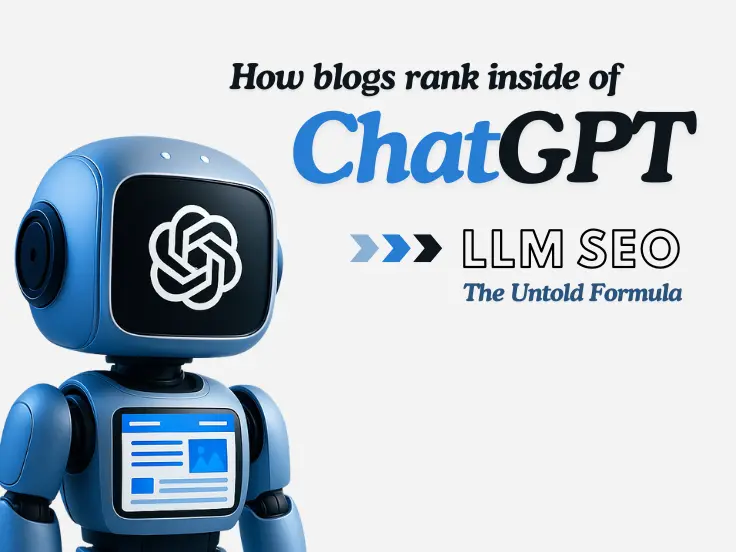Most individuals still think that SEO is all about Google. What if I told you that the real change is taking place elsewhere quietly, in the background in applications such as ChatGPT, Gemini, and Claude?
This isn’t just another trendy term. It’s a real strategy that’s already changing how content gets discovered. If your business isn’t using it yet, you could be missing out. It’s called LLM SEO. That stands for Large Language Model Search Engine Optimization, a fancy name for something simple: writing content in a way that AI tools like ChatGPT can easily read, understand, and recommend. And that matters, because more and more people now trust these tools to find answers, even more than Google.
Let’s break it down, simply and clearly, so you can actually use this.
What exactly is LLM SEO?
LLM SEO means writing your blogs, website pages, and service descriptions in a way that helps AI assistants, like ChatGPT – recommend your business when someone asks a question.
Think of it like this. Traditional SEO is like putting up a signboard on a busy road. If someone passes by, they may notice it. But LLM SEO is like having someone say your name when a user directly asks, “Hey, who do you trust for this?” One is visibility. The other is trust. That’s the difference.
Why does this matter right now?
Because people’s behavior has changed. Instead of Googling everything, they’re now asking AI tools for suggestions, advice, and even medical referrals. And if your content doesn’t show up in those answers, you’re invisible.
And here’s the tricky part: LLMs don’t work like Google. They don’t scroll, they don’t measure bounce rates, they don’t care if your page is pretty. They care about something else entirely.
Let’s explore that.
How do LLMs “read” your content?
Imagine a student trying to understand a topic right before an exam. They don’t read every word, they scan the headings, look for definitions, key points, quotes, and examples. That’s exactly how AI models absorb your site. They pick up structure, clarity, tone, and trust markers.
They understand clear headings. They pull out concise summaries. They pay attention to bullet points, quotes, and links. If your content is a wall of vague text with no structure, they’ll skip it. But if it’s organized, conversational, and credible, they’ll remember it, and reuse it in answers.
So how do you actually apply LLM SEO?
Let’s go step by step.
Start by writing like you’re answering someone’s real question. Use simple, specific headings like “What causes sudden hair fall?” or “Is IVF painful?” – not generic titles like “Understanding fertility.”
Under each heading, start with 2-3 lines that summarize the answer in a natural tone. Then go into details. Try to keep each section short and focused. Imagine a curious person reading on their phone, in between two work meetings. That’s who you’re writing for.
Use formats that help LLMs understand structure. Like bullet points, numbered steps, or mini checklists. If you’re explaining something complex, break it into pieces.
Your tone matters more than ever
Avoid robotic language. Instead, talk like you’re explaining it to a friend or client.
For example, instead of saying, “IVF is a multi-stage process involving hormonal stimulation,” say: “Think of IVF like preparing a small garden. First, we help the eggs grow strong. Then we gently pick the healthiest ones and fertilize them in a lab. Once ready, we place the best one back in the womb, like planting a healthy seed.”
That’s human. That’s memorable. And that’s what LLMs look for.
Quotes are powerful
Add 2–3 good quotes in every blog. They could be from your team, clients, or even your own voice. For example:
“We didn’t realize skipping breakfast was causing my husband’s headaches. Once we fixed that, they almost disappeared.” — A patient at Dr. Anurag’s clinic
Or
“Most patients are scared of the term ‘brain surgery.’ But when we walk them through it, step by step, the fear usually turns into confidence.” — Dr. Anurag Lamba
These aren’t just quotes. They’re trust signals. And LLMs value trust deeply.
Now let’s talk about internal links
Think of your website like a small clinic. Each blog post is a room with useful information. But if none of the rooms are connected, no hallways, no signs, no doors — the visitor won’t know where to go next. They’ll read one thing and leave.
That’s where internal linking comes in. It builds those hallways between rooms. It shows both readers and AI models how your topics connect and more importantly, how deep your knowledge really runs.
Now, AI models like ChatGPT don’t just read one article in isolation. They look at how many useful, context-rich connections you’ve made between your content. They’re looking for a pattern — a story of expertise.
Let’s say you have a blog about “migraine myths.” If you naturally link it to another blog titled “Different Types of Headaches”, and then another one that goes into “When to Consider a Brain Scan,” you’re creating a clear content path. You’re telling the AI — and your human reader — that you understand the full spectrum of this problem. From everyday pain to serious warning signs. From myth-busting to diagnostics.
That’s not just helpful. That’s authority.
And authority is what makes LLMs choose your content over someone else’s.
What makes a good internal link?
It’s not just about throwing hyperlinks everywhere. Here’s how to do it right:
1. Link naturally from within the text
Instead of saying “click here,” use helpful anchor phrases like:
- “See our guide on the different types of headaches”
- “Learn when it’s time to visit a neurologist”
2. Only link to content that’s contextually relevant
If you’re writing about IVF treatment timelines, don’t suddenly link to a blog about diet plans unless it adds to the topic, like fertility nutrition.
3. Don’t overload with links
Two to four high-quality, topic-specific internal links per blog are more than enough. Too many links confuse both readers and AI.
4. Use a mix of formats
Link within paragraphs, list sections, or even CTA-style closing sentences like:
“Want to understand the next steps after brain surgery? Here’s a recovery plan we recommend to patients.”
5. Think in content clusters
If you’re building out a niche like migraines, IVF, or fertility tests, organize content in layers:
- Basic explainers (e.g., “What is a migraine?”)
- Deep dives (e.g., “Why migraines affect women more often”)
- Supportive care (e.g., “Best foods to prevent hormonal headaches”)
- Action-based blogs (e.g., “When to see a neurologist for migraines”)
Each of these should link to each other where it makes sense. That’s what we call a knowledge web, a tightly-knit group of helpful resources all leading back to you.
Why does this matter for AI?
Because when LLMs scan your site, they use internal links to trace topic depth. They’re trying to answer a question like,
“Is this writer just giving surface-level information, or can they guide the user through every stage of this problem?”
If the answer is yes, because you’ve linked to it all, your site becomes more than just a blog. It becomes a trusted source.
So, if you want to be recommended inside AI tools, internal links aren’t optional, they’re essential.
In simpler terms:
“Don’t just write useful blogs. Connect them like chapters of a smart book. That’s what makes AI and your readers trust you.”
Sometimes, it’s not what you say that builds trust. It’s how you quietly prove you know what you’re talking about.
These are what we call quiet signals. Subtle, background details that show both Google and AI tools like ChatGPT that your content isn’t just well-written. It’s credible, trustworthy, and created by real people with real experience.
Let’s break that down.
Start with something simple: the author bio. Avoid using generic lines like “By Admin.” That tells the reader nothing. Instead, include the writer’s name and a short description of who they are, what they do, and why they’re qualified to speak on this topic.
For example:
Written by Dr. Renu Lamba, Fertility Specialist at Gulmohar IVF Panchkula. She brings over 15 years of clinical experience in reproductive medicine.
Just that one line changes the feel of the article. It suddenly feels personal and grounded in experience, not like random information pulled from the internet.
Now go a step further by adding credentials. If you’re covering topics like health, law, finance, or anything that impacts real decisions, people want to know the source is legitimate. Mention qualifications, certifications, degrees, or even years of practice. You don’t have to oversell it. Just be honest and clear.
Next comes your references. Add two or three real sources at the bottom of your blog. These could be research studies, medical guidelines, or trusted websites. For example:
Source: Cleveland Clinic – 2024 Migraine Treatment Guidelines
NIH Study: Hormonal Effects on IVF Outcomes (2023)
Most readers won’t click them, but just seeing them builds trust. And AI models absolutely recognize and value those citations.
When you put these pieces together — a real author name, a short but relevant bio, clear credentials, and trusted citations — you’ve created a foundation of quality. This is what Google and modern AI models refer to as EEAT.
EEAT stands for:
- Experience (Has the author directly worked on or lived through what they’re writing about?)
- Expertise (Does the author have real skills or qualifications related to the topic?)
- Authority (Is the website or person recognized in their field?)
- Trust (Is the content accurate, fair, and helpful to the reader?)
This isn’t about SEO tricks. It’s about creating content that earns respect. In a world full of AI-generated fluff, these quiet signals help your writing rise above the noise.
Think of it like this. A website without EEAT is like a clinic with no doctor’s name on the board and no patient reviews. It might look nice from the outside, but would you go in?
So before publishing, ask yourself:
- Does this blog have a real author attached to it?
- Have we shared their qualifications clearly?
- Are there at least one or two trusted sources backing up the facts?
- Would I trust this article if I were the reader?
If you can confidently say yes, then you’re creating the kind of content that AI models not only understand, but also highlight and recommend.
A quick example
We had a neurology client whose blog on “headaches” wasn’t ranking. We rewrote it with LLM SEO principles: question-based headings, human tone, doctor quotes, and internal links. Within a few weeks, ChatGPT started mentioning that article in real conversations when users asked about chronic migraines. A few weeks later, Google rankings improved too.
Mistakes to avoid
Don’t over-optimize. If you just copy-paste AI outputs or write in vague, templated language, it backfires. LLMs can detect AI-generated content. Also avoid writing just for word count — write to help.
And here’s a big one: don’t leave your site untouched for months. Freshness matters. Update your blogs with new examples, new data, or updated timelines. Even small changes show the content is alive.
What kind of content works best for LLM SEO?
- Explainers (e.g., “What happens in an IVF cycle?”)
- Comparisons (e.g., “IVF vs IUI: What’s right for you?”)
- Myth-busting posts (e.g., “Is it true that headaches mean brain tumor?”)
- Location-based guides (e.g., “Best neurologists in Panchkula”)
- Real stories (e.g., “How a 10-minute test saved her memory”)
Also, publish regularly. Once a month isn’t enough anymore. LLMs pick up patterns. If you publish 4-5 helpful articles every month around your niche — fertility, neurology, hair loss, automation, whatever it is — they begin to trust you. That’s how you become a source.
How much AI-written content is accepted by LLMs, and where is the boundary?
This is one of the most common questions today. People want to know if they can use AI tools like ChatGPT or Gemini to write their blogs and whether the content will be ignored if it’s detected as machine-generated.
The short answer:
Yes, AI can help. But no, you shouldn’t depend on it entirely.
Here’s what you need to understand, broken down clearly:
- AI is fine for idea generation
Use it to brainstorm, outline your blog structure, or generate draft headings. Think of it as your writing assistant, not the writer. - LLMs recognize patterns, not just words
Tools like ChatGPT, Claude, and Gemini are trained to spot repetitive phrasing, predictable flow, and emotionless writing. If it reads like a stitched-up template, it’s less likely to be recommended. - The final tone must sound human
Add your real opinions, examples, and the way you naturally speak. Use your own logic and voice to guide the final version. - Balance matters
A helpful approach is to use AI for the first half (idea + structure), and then apply your own tone and clarity for the second half (refinement + emotional depth). - Before publishing, always do a personal read-through
If something sounds flat, awkward, or too robotic, rewrite it. Ask yourself, “Would I say this to a real person?” - What happens if you skip the human touch?
Your content might still be scanned by the LLM, but it won’t be selected or cited. It may even be tagged as low-value or generic, even if it’s factually correct. - LLMs don’t punish AI use — they just reward effort
What matters most is usefulness. If your blog helps the reader, feels natural, and includes thoughtful context, it will pass the test. - Respect the reader, not the algorithm
Speak with clarity, kindness, and intent. That is what both humans and AI respect.
To simplify the entire idea:
AI can be your assistant. But the heart of the message – the emotion, trust, and understanding, should always come from you.
How do LLMs detect AI-written content?
Many people wonder if there’s a clear way to tell when something is flagged as AI-generated. The answer is not exact, but we do know the signals LLMs pay attention to.
AI models like ChatGPT, Gemini, and Claude look for clues in your writing. They are trained to spot patterns that feel overly robotic or generic. If your blog sounds like it was generated without any human thought behind it, it may not be chosen or recommended — even if it’s technically correct.
Here’s what LLMs typically consider when evaluating whether content was written by a machine:
- Repetitive or generic phrases
Sentences like “In today’s digital world” or “Leveraging cutting-edge solutions” often appear in low-effort AI outputs. These phrases don’t add value and may lower your credibility in the eyes of the model. - Overly uniform structure
If every paragraph follows the same format and rhythm, with little variation, it starts to sound mechanical. Real human writing has natural pauses, shifts in tone, and variation in sentence length. - Lack of personal voice or context
Blogs without real-life examples, opinions, or emotional depth feel lifeless. LLMs often prefer content that sounds grounded in personal experience or care. - Missing specific details
Vague explanations or surface-level answers are a red flag. AI tends to write generalizations unless guided properly. Human writers usually add things only they would know — that makes a difference. - No clear signs of authorship or credibility
Content that doesn’t include an author name, credentials, or sources is seen as less trustworthy by both AI and human readers.
Despite all this, LLMs don’t automatically reject AI-assisted writing. What they really value is usefulness. If your content clearly answers a real question, includes specific and helpful details, and sounds like a person wrote it with intention, it’s more likely to be chosen.
You can still use AI to draft or organize your thoughts. But always review the final version and ask yourself: Would I say this in real life? Does it reflect how I think and speak?
If yes, you’re already doing better than most.How to measure success in LLM SEO
One of the biggest challenges with LLM SEO is that you won’t always find clear results inside your Google Analytics dashboard. The kind of visibility you get through ChatGPT, Gemini, or Claude often leaves no digital trail. But that doesn’t mean it’s invisible.
You just need to know what signs to look for.
Here are the real-world signals that show your LLM SEO efforts are working:
- You start noticing more “direct” traffic
When people type your URL directly into the browser or come to your site without clicking a search result, it could mean they found you through an AI answer and decided to check you out on their own. - More people are searching your brand name
If you see a rise in search queries like “Dr. Anurag Panchkula neurologist” or “Gulmohar IVF Panchkula success rate,” that’s a strong sign that someone heard about you through a conversation with an AI tool. - Patients or clients say things like “I found you mentioned in ChatGPT”
This is becoming more common, especially among younger, tech-savvy audiences. Pay attention to how people describe how they discovered you. - You get featured in AI-generated content summaries
Tools like Perplexity, Bing AI, and even some Google search experiments are starting to show blog citations and links pulled directly from LLM-friendly content. If your blog is structured well, there’s a chance it appears in these snapshots. - You ask ChatGPT or Gemini questions in your niche, and your blog is referenced
Try this: Ask ChatGPT a question your ideal audience might ask. Then see if your website, article title, or brand is mentioned. If it is, you’re doing something right. - Your bounce rate drops and time-on-page increases
While not exclusive to LLM SEO, this is a good supporting metric. LLM visitors often land with specific intent. If your content answers their question well, they’re likely to stay longer and explore more pages. - You receive more qualified leads without running ads
When the leads you’re getting are already educated about your service, know your name, or ask fewer basic questions, it’s often because they’ve interacted with your content beforehand — possibly through AI answers.
LLM SEO success doesn’t shout. It whispers in patterns.
You’ll know it’s working when people come in with trust already built. When they say, “I read about this on your site” or “You were the only clinic that answered it clearly,” that’s proof your content is living and working inside these new AI-powered ecosystems.
Final takeaway
- You don’t need more blogs
You need blogs that build trust. That’s what LLM SEO helps you create. - LLM SEO is not replacing Google SEO
It’s an added layer that helps your content show up inside AI answers, not just on search engine results pages. - If Google is the road, LLMs are the GPS
People are no longer just searching. They’re asking. Your content must be ready to be the answer. - If your blog isn’t being recommended, someone else’s will be
Visibility in AI is now competitive. Your content needs to be the most useful, human, and trustworthy. - Start small
Take one blog post. Add headings that answer real questions. Include quotes. Use examples from your own experience. - Structure it like a helpful guide
Use bullet points, internal links, FAQs, and a clean, readable format. This helps both readers and language models. - Make it sound like you
Don’t copy-paste from AI tools. Edit it. Personalize it. Speak to the reader the way you would in person. - Keep it fresh and relevant
Update your content regularly. Add new examples, stats, and answers based on real audience questions.






